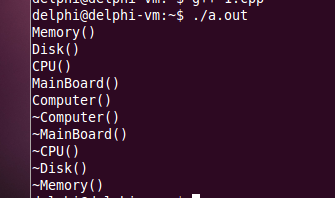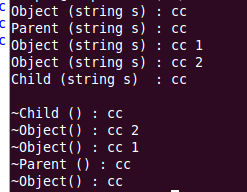1.子类对象的构造
a.子类中可以定义构造函数
b.子类构造函数
必须对继承而来的成员进行初始化
1).直接通过初始化列表或者赋值进行初始化
2).调用父类构造函数进行初始化
1).直接通过初始化列表或者赋值进行初始化
不可行,子类无法访问父类中的private成员。所以对这部分成员无法初始化
2).调用父类构造函数进行初始化
默认调用
适用于无参构造函数和使用默认参数的构造函数
显示调用
通过初始化列表进行调用;使用于所有父类构造函数;
class Child : public Parent
{
public:
Child() /* 隐式调用 */
{
cout << "Child() : " << endl;
}
Child(string s) : Parent("Parameter to Parent") /* 显示调用 */
{
cout << "child() : " << s <<endl;
}
}
2.子类对象的构造规则
a.子类对象在创建时会首先调用父类的构造函数
b.先执行父类构造函数再执行子类的构造函数
c.父类构造函数可以被隐式调用或者显示调用
3.对象创建时构造函数的调用顺序
a.调用父类的构造函数
b.调用成员变量的构造函数
c.调用类自身的构造函数
总结:先父母,后客人,再自己
eg:
#include <iostream>
#include <string>
using namespace std;
class Parent
{
public:
Parent ()
{
cout << "Parent ()" << endl;
}
Parent (string s)
{
cout << "Parent (string s) :" << s << endl;
}
};
class Child : public Parent
{
public:
Child ()
{
cout << "Child ()" << endl;
}
Child (string s) : Parent(s)
{
cout << "Child (string s) :" << s << endl;
}
};
int main()
{
Child c;
Child cc("cc");
return 0;
}

4.析构函数的调用顺序与构造函数相反
a.执行自身的析构函数
b.执行成员变量的析构函数
c.执行父类的析构函数
eg:
#include <iostream>
#include <string>
using namespace std;
class Object
{
string ms;
public:
Object (string s)
{
cout << "Object (string s) : " << s << endl;
ms = s;
}
~Object ()
{
cout << "~Object() : " << ms << endl;
}
};
class Parent : public Object
{
string ms;
public:
Parent () : Object("Default")
{
cout << "Parent ()" << endl;
ms = "Default";
}
Parent (string s) : Object(s)
{
cout << "Parent (string s) : " << s << endl;
ms = s;
}
~Parent()
{
cout << "~Parent () : " << ms << endl;
}
};
class Child : public Parent
{
Object mO1;
Object mO2;
string ms;
public:
Child () : mO1("Default 1"), mO2("Default 2")
{
cout << "Child ()" << endl;
ms = "Default";
}
Child (string s) : Parent(s), mO1(s + " 1" ), mO2(s + " 2" )
{
cout << "Child (string s) : " << s << endl;
ms = s;
}
~Child ()
{
cout << "~Child () : " << ms << endl;
}
};
int main()
{
Child cc("cc");
cout << endl;
/* Object (string s) : cc
* Parent (string s) : cc
* Object (string s) : cc 1
* Object (string s) : cc 2
* Child (string s) : cc
*
* ~Child () : cc
* ~Object() : cc 2
* ~Object() : cc 1
* ~Parent () : cc
* ~Object() : cc
*/
return 0;
}
